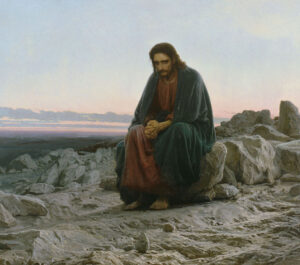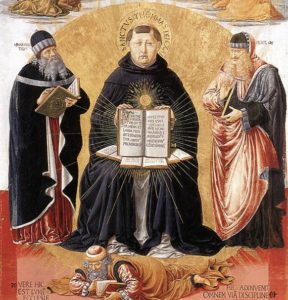The 40 Days of Lent
by Fr. William Rock, FSSP

The Gospel for the First Sunday of Lent is St. Matthew’s account of Our Lord’s 40-day fast in the desert and His subsequent temptation by the devil (4:1-11). This is a fitting Gospel to have proclaimed on the solemn inauguration of Lent (which officially started the Wednesday previous) as Lent, the Church’s own 40-day period of fast, is patterned on the fast recounted in this Gospel pericope. Our Lord’s fast was itself prefigured by the 40-day fasts of Moses (Exo 24:12-18) and Elias (3 Kin 19:3-8), the accounts of which are read a few days following this Sunday, on Ember Wednesday of Lent.
But what is the significance of 40 days? According to Dr. Nathanael Schmiedicke’s Handy Guide to Biblical Numerology, the number 40 “is often used in connection with a time of trial and preparation for a new stage in Man’s relationship with God.” This is certainly true in the case of Moses, who, after his 40-day fast, received from God revelation concerning the covenant and divine worship. This meaning of the number 40 can also be applied to the 40 days and nights of rain which caused the Flood, after which mankind began anew, as it were, and the 40 years of the Hebrews wandering in the desert, after which the new generation undertook to conquer the Promised Land, a task which the preceding generation refused. Our Lord’s preaching, which set the foundation for the New and Everlasting Covenant between God and His Faithful, was inaugurated after His 40-day fast. In this sense, then, the Church’s fast can be seen as a period of “trial,” as 40 days of fasting is difficult, but also as the “preparation for a new stage in Man’s relationship with God,” for by this fast one should subdue the rebellious flesh and enter into a new, that is improved, relationship with God.
St. Gregory the Great, in a sermon, noted that the fast of Lent can be seen as serving as a tithe of the year to God.
The Creator of all things took no food whatever during forty days. We also, at the season of Lent as much as in us lies afflict our flesh by abstinence. The number forty is preserved, because the virtue of the decalogue is fulfilled in the books of the holy Gospel; and ten taken four times amounts to forty. Or, because in this mortal body we consist of four elements by the delights of which we go against the Lord’s precepts received by the decalogue. And as we transgress the decalogue through the lusts of this flesh, it is fitting that we afflict the flesh forty-fold. Or, as by the Law we offer the tenth of our goods, so we strive to offer the tenth of our time. And from the first Sunday of Lent to the rejoicing of the paschal festival is a space of six weeks, or forty-two days, subtracting from which the six Sundays which are not kept there remain thirty-six. Now as the year consists of three hundred and sixty-five, by the affliction of these thirty-six we give the tenth of our year to God.1

Before Ash Wednesday and the following days were added to Lent (bringing the number of fasting days up 40), the Lenten season started on the First Sunday, giving 36 fasting days. These 36 days were seen as a tenth of the 365 days of the calendar. These 36 days, a tenth of the year, were offered to God as a tithe (which is the giving of a tenth of some good). Perhaps this idea of Lent being a tithing of the year motivated the choice of the First Lesson of Ember Saturday in Lent (Deu 26:12-19) which begins: “When thou hast made an end to tithing all thy fruits, thou shall speak thus in the sight of the Lord thy God…” This tithing interpretation can still hold more-or-less, even though now 40 days are being offered instead of 36. The Holy Pontiff also notes that 40 can represent the 10 Commandments being fulfilled by the 4 Gospels (10*4=40)
In his 55th Letter (n. 28), St. Augustine explains that 40 symbolizes the labor of this life.
Now, in what part of the year could the observance of the Fast of Forty Days be more appropriately placed, than in that which immediately precedes and borders on the time of the Lord’s Passion? For by it is signified this life of toil, the chief work in which is to exercise self-control, in abstaining from the world’s friendship, which never ceases deceitfully caressing us, and scattering profusely around us its bewitching allurements. As to the reason why this life of toil and self-control is symbolized by the number 40, it seems to me that the number ten (in which is the perfection of our blessedness, as in the number eight, because it returns to the unit) has a like place in this number; and therefore I regard the number forty as a fit symbol for this life, because in it the creature (of which the symbolic number is seven) cleaves to the Creator, in whom is revealed that unity of the Trinity which is to be published while time lasts throughout this whole world — a world swept by four winds, constituted of four elements, and experiencing the changes of four seasons in the year.

According to Augustine, one arrives at the number 40 first by considering that the creature (which can be represented by the number 7 due to the seven days of creation) seeks to be united to the Creator (which can be represented by 3 for the Persons of the Trinity). The unity of 3 and 7 is 10. This unity between creature and Creator should be universal, which can be represented by the number 4 as the four winds, the four elements (see below), and the four succeeding seasons of the year indicate the whole world. 10 spread 4 times over gives 40 (10*4=40). The Saint notes that this season of 40 days occurs before the 50 days of Easter, which itself represents the future life of beatitude. Therefore, the labors of the 40 days of Lent represent the entirety of the labors of this life, which, God willing, will give place to the period of eternal rest, symbolized by the 50 days of Easter.
This understanding of Augustine also explains why Our Lord remained with His Apostles for 40 days after His Resurrection. Before His Ascension, Our Lord told His Apostles, “And behold I am with you all days, even to the consummation of the world” (Mat 28:20). As 40 represents this life, the 40 days between His Resurrection and Ascension symbolize His presence with the Church until the end of time. One should not be disturbed by the days after Easter having multiple symbolic meanings. It is perfectly acceptable for passages of Scripture, and thus also the Church’s Liturgy, to have several non-contradictory meanings.
It is worth noting that in another place, namely in his Harmony of the Gospels (II, 4, 9), St. Augustine explains that 10 is found by summing what mathematics would call today the first four positive whole numbers (1+2+3+4=10) (this means that 10 is a triangular number, just like 153, the number of Aves in a full Rosary). And, of course, 4 times 10 is 40. From here, one can then inquire into the meaning of 10 and 4, which will provide results similar to those presented above. St. Augustine also explains that just as St. Matthew’s genealogy (1:1-16) has Our Lord descending to us by the number 40 (40 men, not including Our Lord, are listed), so do the Faithful rise to Our Lord by the number 40 (40 days of fasting).2
St. Thomas Aquinas, in his Commentary on St. Matthew (n. 313), echoes one of the reasons given by St. Gregory as to why the fast should last 40 days.
And one should know that this number is prefigured in the Old Testament in Moses and Elias (Exod 24:18: 1 [3] Kgs 19:8). And a mystery is hidden in this, because such a number arises from ten multiplied by four. The ten signifies the law, because the whole law is contained in ten precepts. The four signifies the composition of the body, because the body is composed out of four elements. Since therefore we transgress the divine law at the suggestion of the body, it is just that we afflict our body for forty days.

According to the medievals, the human body was composed out of the four elements – earth, water, air, and fire. Even though this is incorrect, perhaps this passage of St. Thomas can be interpreted in the context of modern science. To begin with, these four elements can be seen as corresponding to the four primary states of matter – solid, liquid, gas, and plasma – by which material creation is primarily composed. Matter in each of these states can also be involved in sin. For example, sinning against one’s neighbor would involve the solids, liquids, and gases which composed the neighbor (and the self). Idolatry involving stars would involve matter in the state of plasma. St. Thomas’s explanation can be re-expressed, then, as follows:
The ten signifies the law, because the whole law is contained in ten precepts. The four signifies material creation, because material creation is primarily composed out of matter in four states. Since therefore we transgress the divine law by means of material creation, it is just that we afflict our body for forty days.
Even if some may find this reinterpretation of St. Thomas not overly convincing, this takeaway is still valid – Lent is, at its heart, a season of reparation for sin.
In answer to the question posed at the start, there are complimentary ways of understanding the significance of the fast of Lent being 40 days. These understandings build on each other to reveal the depth of a season which has its own worth apart from its purpose as a preparation for the celebration of Easter. Knowing this, may the Faithful enter into and keep this season with a renewed and deeper appreciation.
Fr. Wiliam Rock, FSSP was ordained in the fall of 2019 and is currently assigned to Regina Caeli Parish in Houston, TX.
In support of the causes of Blessed Maria Cristina, Queen, and Servant of God Francesco II, King
- Hom. in Ev., 16, 5 (according to the Catena Aurea).
- See Durandus, Gulielmus. Rationale Divinorum Officiorum, VI, XXXII, 2. The reference of Augustine is cited as De Consec. dist. 5. Jejunium. Durandus also associates the 46 years the Second Temple was being renovated (Joh 2:20) to the 46 totals days of Lent (which traditionally would have all been days of abstinence, so Lent would have been 46 days of abstinence and 40 days of fasting). Just as 46 years were used unknowingly to renovate and beautify the Temple for the coming of the Messiah, so should the Christian knowingly spend 46 days in abstinence and good work beautifying the soul with virtue in preparation for the celebration of Messiah’s Resurrection (VI, XXVIII, 3).
February 18, 2024









